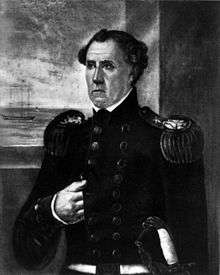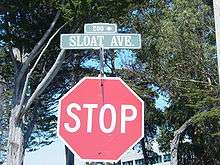John D. Sloat
| John Drake Sloat | |
|---|---|
 | |
| 1st Military Governor of California | |
|
In office July 7 – 29, 1846 | |
| Preceded by | Pío Pico (civil governor) |
| Succeeded by | Robert F. Stockton |
| Personal details | |
| Born |
July 6, 1781 Sloat House, Sloatsburg, New York |
| Died |
November 28, 1867 (aged 86) New Brighton, New York |
| Resting place | Green-Wood Cemetery, New York City |
| Awards |
Sloat The Sloat Monument in Monterey was built in his honor. |
| Military service | |
| Allegiance |
|
| Service/branch |
|
| Years of service | 1800–1861 |
| Rank |
|
| Unit | United States |
| Commands |
Grampus St. Louis Pacific Squadron |
| Battles/wars |
War of 1812 Action of 2 March 1825 Mexican–American War |
John Drake Sloat (July 6, 1781 – November 28, 1867) was a commodore in the United States Navy who, in 1846, claimed California for the United States.
Life
He was born at the family home of Sloat House in Sloatsburg, New York, of Dutch ancestry, and was orphaned at an early age, his father, Captain John Sloat, having been mistakenly shot and killed by one of his own sentries two months before he was born,[1] and his mother dying a few years later. Sloat was brought up by his maternal grandparents.
Appointed midshipman in the Navy in 1800, he was sailing master of the frigate United States under Commodore Stephen Decatur during the War of 1812, and was promoted to lieutenant for conspicuous gallantry in the capture of the frigate HMS Macedonian. Sloat then commanded the schooner Grampus during which he fought the Action of 2 March 1825 against the pirate ship of Roberto Cofresí. He later served on the ships Franklin and Washington, and from 1828 commanded the sloop St. Louis with the rank of master commandant, to which he had been promoted in 1826. He was promoted to captain in 1837, and from 1840 to 1844 was in charge of the Portsmouth Navy Yard.[2]
California

In 1844 Sloat was appointed to command the Pacific Squadron, and in 1845, as tensions with Mexico grew, he was instructed to land in Alta California and claim it for the United States if war broke out. Receiving a report of fighting on the Texas border while off Mazatlán, he raced north (the British were reportedly interested in California too), engaged in a skirmish called the Battle of Monterey, raised the flag over the Customs House at Monterey on July 7, 1846, and issued a proclamation announcing that California was now part of the United States. He was a Military Governor of California for only twenty-two days, before handing over the office to Robert F. Stockton.[3]
Later, his poor health forced Sloat to take commands ashore, where he commanded the Norfolk Navy Yard 1847-51,[4] directed the construction of the Stevens Battery in 1855, and helped plan the Mare Island Navy Yard. He retired with the rank of Captain in December 1861, and was promoted to Rear Admiral on the retired list in July 1866. Sloat was a Freemason, and belonged to St. Nicholas lodge No. 321 in New York City. He died in New Brighton, New York, and was buried in Brooklyn's Green-Wood Cemetery.
Legacy

Two destroyers have been named USS Sloat in his honor as well as a World War II Liberty ship, the SS John Drake Sloat. A major street, Sloat Boulevard, and Commodore Sloat elementary school, both in San Francisco, are named after him. Local streets in Monterey, California, Sacramento, California, and the Carthay Circle neighborhood of Los Angeles also bear his name. There is a large monument erected in his honor on the Presidio of Monterey U.S. Army post. An elementary school in Sacramento is also named for him. His home town in New York was also named Sloatsburg, after his grandfather Stephen and his family.
Dates of Rank
- Midshipman - 12 February 1800
- Sailing Master - 10 January 1812
- Lieutenant - 24 July 1813
- Master Commandant - 21 March 1826
- Captain - 9 February 1837
- Reserved List - 27 September 1855
- Retired List - 21 December 1861
- Commodore on Retired List - 16 July 1862
- Rear Admiral, Retired List - 25 July 1866
Notes
- ↑ Tholl, Claire (May 1974). "National Register of Historic Places nomination, Sloat House". New York State Office of Parks, Recreation and Historic Preservation. Retrieved 22 August 2010.
- ↑
 Rines, George Edwin, ed. (1920). "Sloat, John Drake". Encyclopedia Americana.
Rines, George Edwin, ed. (1920). "Sloat, John Drake". Encyclopedia Americana. - ↑ Ruhge, Justin (February 8, 2016). "The Mexican War and California: Monterey's Presidio Occupied and Improved". militarymuseum.org.
- ↑
 Gilman, D. C.; Thurston, H. T.; Colby, F. M., eds. (1905). "Sloat, John Drake". New International Encyclopedia (1st ed.). New York: Dodd, Mead.
Gilman, D. C.; Thurston, H. T.; Colby, F. M., eds. (1905). "Sloat, John Drake". New International Encyclopedia (1st ed.). New York: Dodd, Mead.
Further reading
Knickerbocker Commodore: The Life and Times of John Drake Sloat, 1781-1867 by Bruce A. Castleman, 2016, State University of New York Press
References
- Proclamation to the Inhabitants of California (7 July 1846).
- This article incorporates text from the public domain Dictionary of American Naval Fighting Ships. The entry can be found here.
